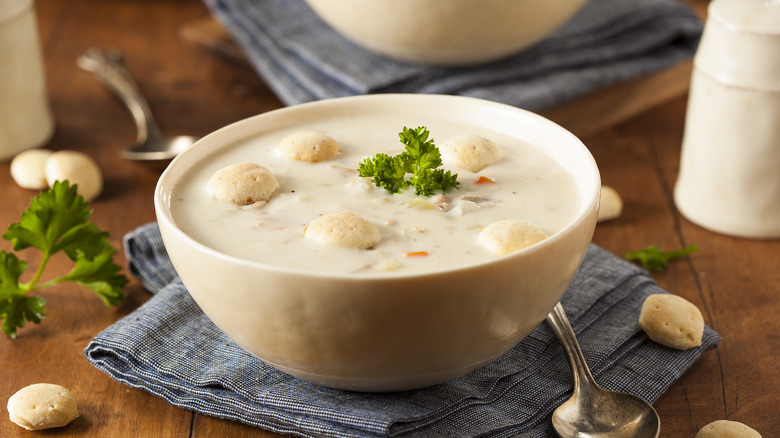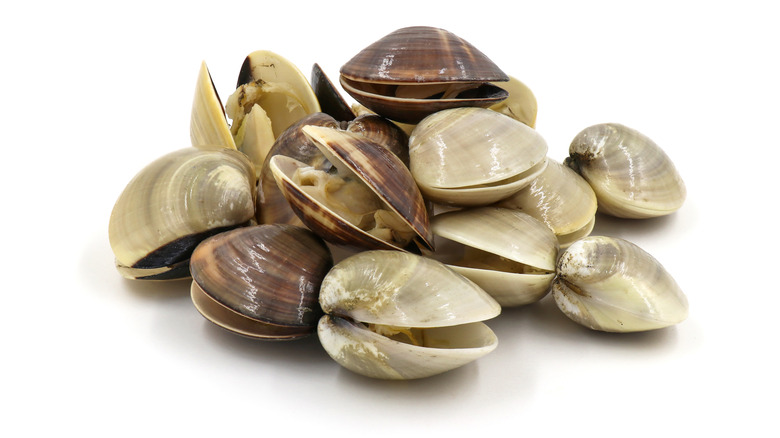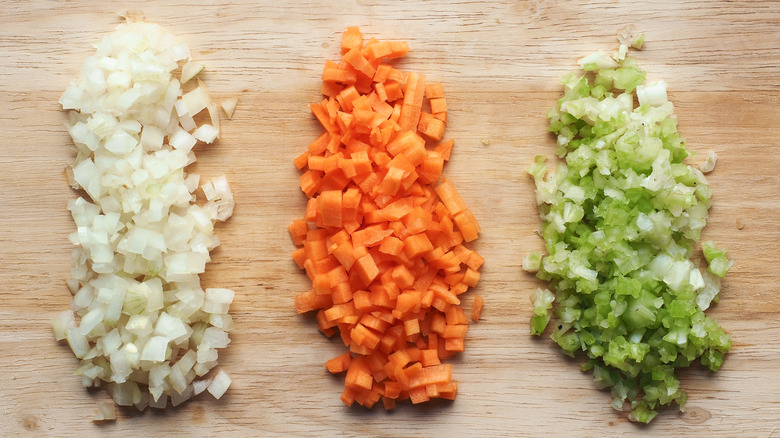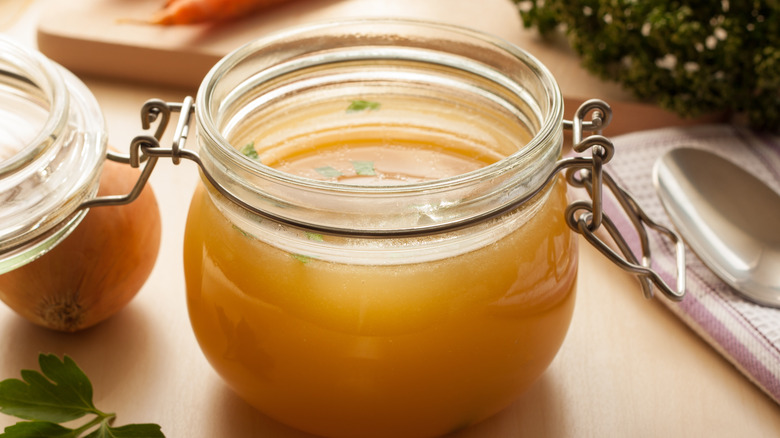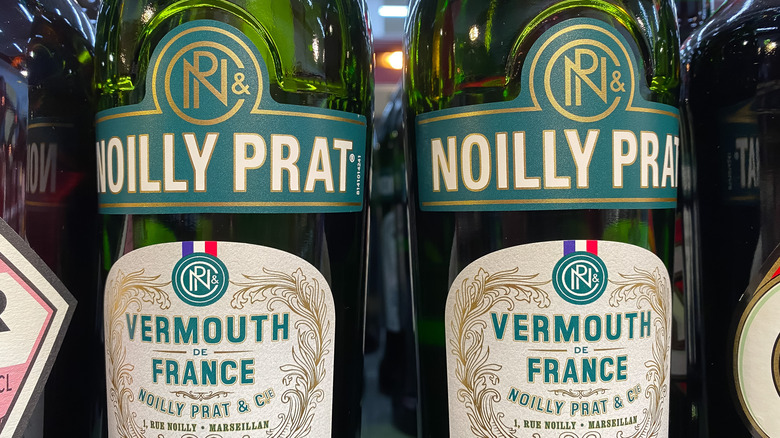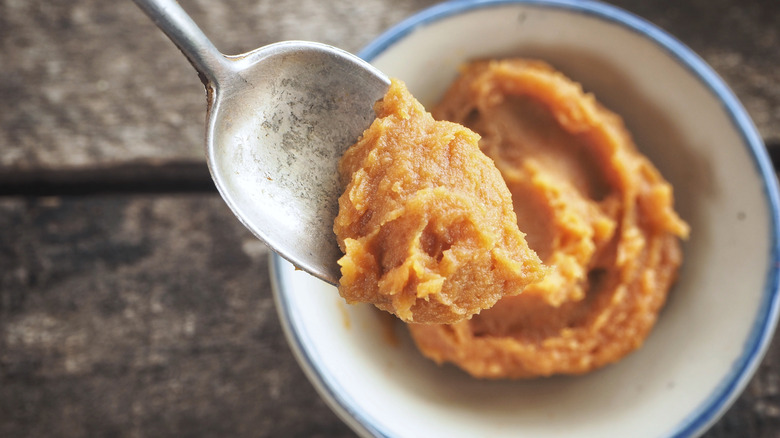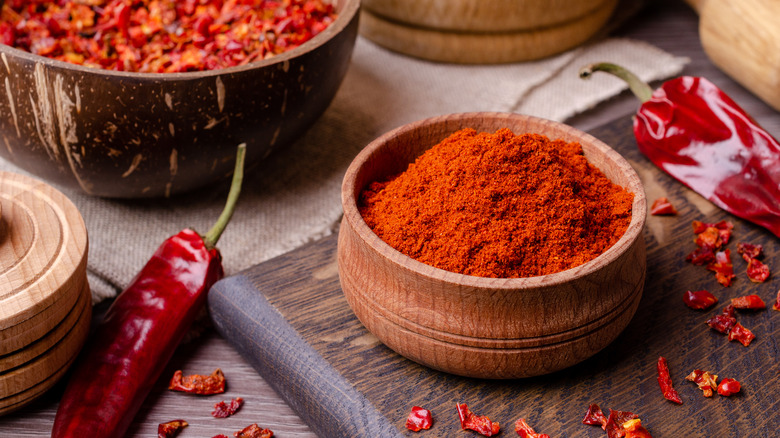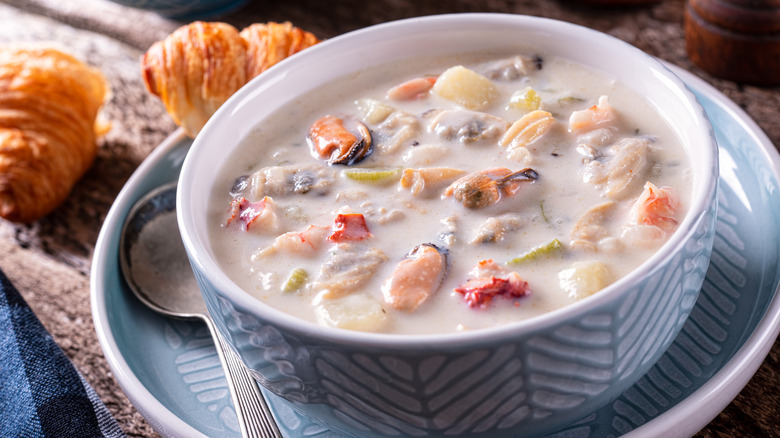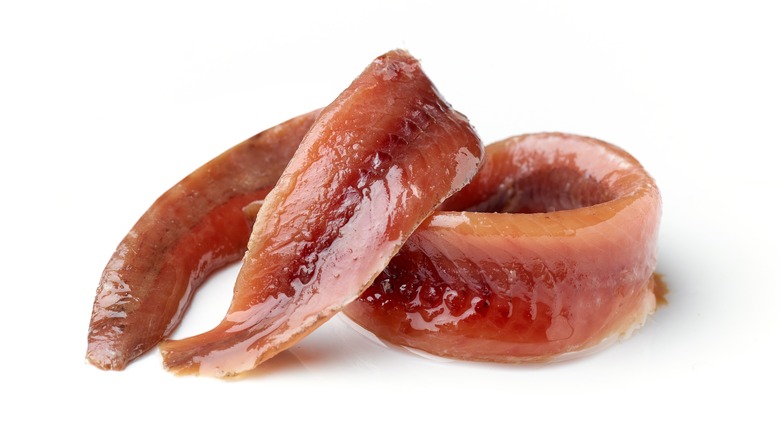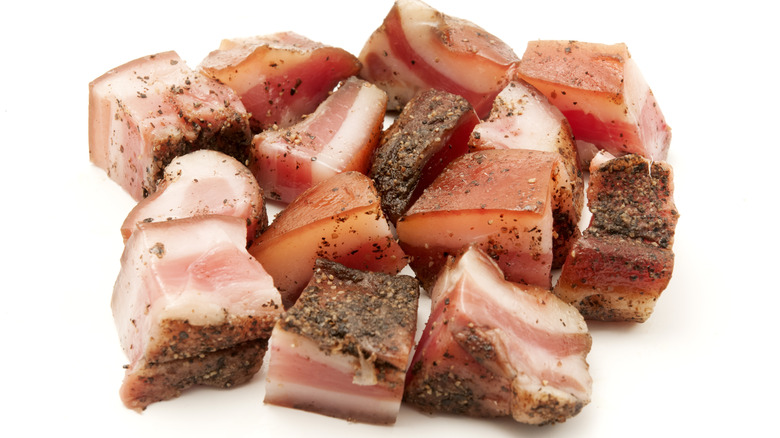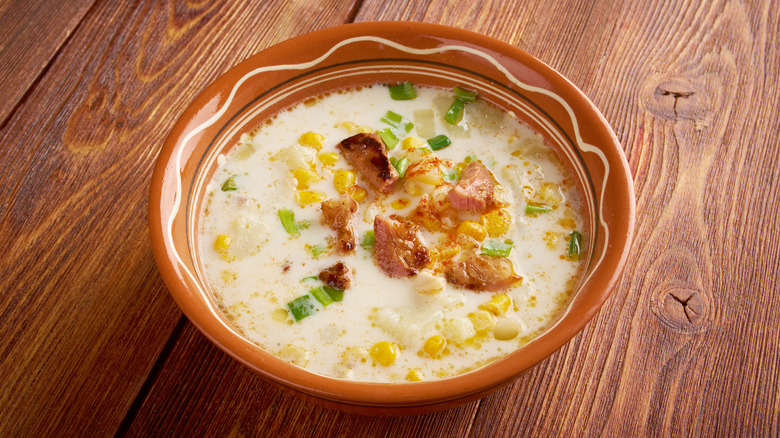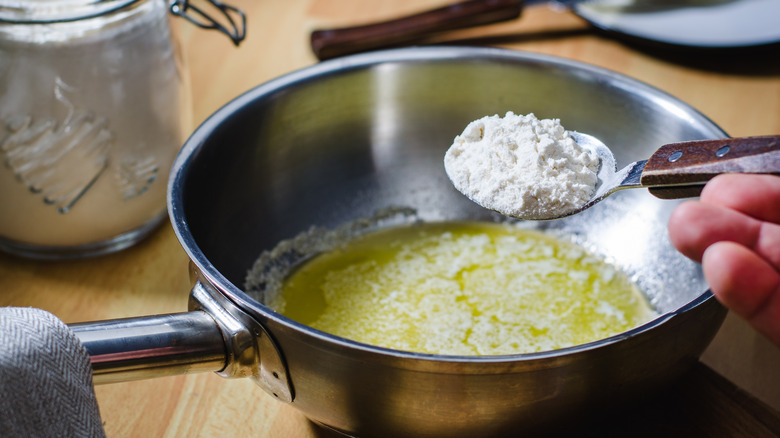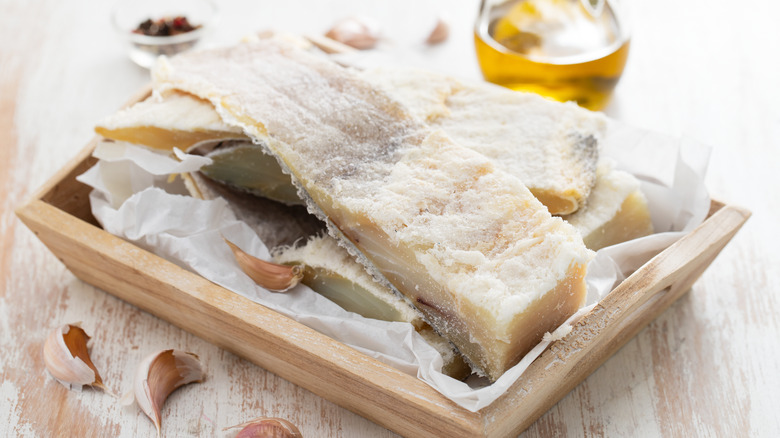12 Ways Chefs Like To Upgrade Their Clam Chowder
Clam chowder is a classic comfort food that has a long history. This rich, briny soup can be traced back to the 1700s when it was found on the Atlantic coast. European settlers and the local indigenous population both made chowder with the abundance of clams in the area. Once thought to be a poor man's food, the humble chowder began to rise in popularity as comfort food. With the addition of potatoes, pork, and cream, the classic New England clam chowder was born, and it's been popular ever since. Author Herman Melville even mentions the steamy soup in his seafaring classic Moby Dick.
Throughout the years, clam chowder morphed, and in the 1930s, with the swap of a cream base for a tomato base, the Manhattan clam chowder was created, albeit to intense criticism from New Englanders who defended their classic recipe. Later, many other iterations of clam chowder were created, like the Rhode Island clam chowder that replaces cream and tomatoes with a clam broth and the New Jersey clam chowder with creamed asparagus and Old Bay spice.
With so many different versions of clam chowder, it's no surprise that chefs have created some of their own versions by upgrading their clam chowder in a variety of ways. If you love the creamy soup and don't mind veering from the classic recipe, then you can get inspired by ways chefs like to upgrade their clam chowder.
Fresh clams
Chef Ina Garten (aka The Barefoot Contessa), is known for her no-nonsense approach in the kitchen. She is a chef that understands that real home chefs don't always have the time or the budget for fancy or expensive ingredients; she knows the shortcuts that don't shortchange on flavor and always shares them with her audience. But when it comes to her clam chowder, she explains there are no shortcuts — it's fresh clams or no dice. She insists that fresh clams are the only way to make good clam chowder (via YouTube). So if you want to make an excellent — not just okay — clam chowder, it is time for a trip to your local fishmonger to find the freshest clams available.
Using fresh shellfish may be intimidating for some, but once you master the art of cleaning and steaming them, you will leave the canned clams behind for good. Ina recommends adding the fresh clams at the end of the cooking process to avoid overcooking them to a rubber state.
Another way Ina veers from the traditional recipe is by including carrots and starting with sauteed onions as a base. Potatoes don't have to be the only vegetable in clam chowder, and carrots add a hint of sweetness to the savory soup.
Start with a mirepoix
Chef Emeril Lagasse starts his clam chowder with a classic mirepoix of diced carrots, celery, and onions for an aromatic beginning (via YouTube). A mirepoix is where many amazing soups and stews start, so it makes sense to give his clam chowder such a tasty base. The classic French mirepoix is all about the ratio and having the right ratio of ingredients. It should be 1 part celery, 2 parts onions, and 1 part carrots and always cooked in fat low and slow to bring out the flavor of the trio.
From his mirepoix base, he takes the classic clam chowder for a healthy spin by adding another vegetable, sweet corn (via YouTube). Sweet corn not only adds some sweetness to balance out the briny soup but also adds texture which is a nice contrast to the creamy potatoes and chewy clams. He finishes his clam chowder with a handful of fresh parsley and a pinch of cayenne.
Skip chicken stock
Television personality and chef Michael Symon steers clear of chicken broth in his clam chowder and instead opts for clam broth. He shared on Twitter that chicken stock is not in his recipe. This is a break from many clam chowder recipes that use chicken stock as a base. For home chefs that want to try his chicken stock-less version, you will need to get your hands on some clam broth which isn't always readily available. Luckily, it's easy to make; just use the water left over from boiling your fresh clams, and you are ready to go.
Another chef that forgoes the chicken stock is chef Matty Matheson. He starts his clam chowder, which he calls the Ultimate Clam Chowder, with a fumet (via Vice). A fumet is a concentrated stock made with fish or meat, and vegetables. He makes his fumet with the head and bones of fresh cod and aromatics like celery, leeks, and garlic.
Add dry Vermouth
Chef Alex Guarnaschelli and the queen of everything homemaking, Martha Stewart, both use some spirits in their clam chowder. Guarnaschelli opts for vermouth in her clam chowder. While vermouth is more often found in the bar than the kitchen, this alcohol that is the key to a good martini can do double duty in the bar and the kitchen. Vermouth is a fortified wine flavored with different botanical extracts. The three most common types of vermouth are sweet red, sweet white, and dry white. Guarnaschelli opts for a cup of dry white vermouth in her clam chowder for a richer taste. She also adds 1 tablespoon of dry marsala which adds a slight fruitiness to balance out the smoky bacon.
Stewart saves her dry vermouth for her seafood chowder – and for her clam chowder, she reaches for dry sherry, another fortified wine. Dry sherry differs from dry vermouth in that it has a fruity, nutty taste, and dry vermouth leans to the sweeter side with herbal notes.
Stir in miso
One common mistake that happens with clam chowder is that it is too bland. With the cream base and white potatoes, clam chowder runs the risk of lacking the right flavor and having a mild taste that is just missing something. Sometimes it is because the potatoes have soaked up the salt or the base is just too thick, and the chowder is weak in flavor and has a heavy texture. If you find your clam chowder leaning into no-flavor-land, try adding a bit of miso paste to the pot for a rich umami kick. A little miso will amp up the flavor without making it too salty. And when you add miso, it can help thin out your chowder and give it some life.
There are different types of miso red, yellow, and white. White miso is the mildest and will be the best choice to add to clam chowder. Not only will it not overpower the delicate clam flavor, but it won't alter the color either. Recipe developer and New York Times cooking contributor, Kay Chun, uses a quarter cup of white miso in her recipe for clam chowder.
Sprinkle in some heat with Cayenne pepper
When you eat clam chowder in a restaurant, chances are there is a bottle of the classic hot sauce Tabasco on the table for a few drops of heat. The heat combined with the creaminess of the chowder is a taste sensation. And chef Michael Kornick goes even further with the heat and adds cayenne pepper directly to the pot. Cayenne pepper cooked into the base adds a smoky heat that does not overpower the salty taste and velvety texture. Instead, it gives the clam chowder a fuller, more complex flavor.
Emeril Lagasse also adds cayenne pepper to his clam chowder. He adds relatively little, just 1/8 teaspoon, but he takes it a bit further with 1 teaspoon of Worcestershire sauce and 1 teaspoon of Old Bay seasonings. The mix is the perfect way to spice up clam chowder with nuanced layers of flavor and not just the one note of heat that cayenne brings.
Mixing in other seafood
Chef Andrew Zimmern, everyone's favorite chef with an adventurous palate, likes to take his clam chowder up a notch by mixing in more of a good thing: seafood. His clam chowder has mussels and halibut in addition to clams. To balance the extra seafood, he adds a cup of white wine to the creamy base, which adds a bit of acid and also thins the soup so it's not so heavy. The addition of mussels and clams make the chowder rich, so a slightly thinner base is the perfect complement.
While we can't know for sure, the well-traveled television host may have been inspired by the Irish version of clam chowder. Irish chowder is chock full of all kinds of goodies from the sea. The country, which is surrounded by water, has a long history of using everything the sea has to offer. Irish chowder uses a mix of classic ingredients like clams and potatoes, but they also add smoked fish for a hefty flavor — and wine for a balanced chowder.
Anchovy paste
Anchovy paste is a little secret in the culinary world for adding more flavor to many dishes. The trick is to use just enough for some salty umami but not too much that it steals the show. Chef and television personality Giada De Laurentiis always keeps anchovy paste on hand as it can save any dish.
Food Network star and chef Bobby Flay reaches for anchovy fillets in his clam chowder. Flay's clam chowder swaps out the heavy cream for a crème fraîche, and he adds a little heat with Calabrian chili flakes. The salty umami of the anchovies with the heat of the smoky chili and the coolness of the crème fraîche makes the perfect balance that works as a symphony — each distinct flavor playing its part and none of them overwhelming the other. Flay goes one step further and adds tomato paste, making a hybrid clam chowder that walks the line between a white New England clam chowder and a red Manhatten clam chowder for a unique taste and color.
Swap bacon for guanciale
All pork is not the same. Bacon, guanciale, and pancetta may come from the same animal, but they have some nuances in flavor and texture that can add something new to clam chowder. Chef Christian Petroni skips the bacon in his clam chowder and instead uses guanciale cut in lardons and prosciutto cut in chiffonade. Guanciale, the pork cheek or jowls, is a fatty meat that stands out in this creamy soup. And the prosciutto adds a subtle flavor and texture that contrasts nicely with the meaty clams and soft potatoes. Smoky Calabrian chili paste adds a little heat, and dry white wine lends some acid to his final dish.
Chef Gabriel Corcos reaches for pancetta for his take on clam chowder. Pancetta is pork belly that is not smoked and instead salt-cured. His recipe starts with cooking the pancetta in oil to give it a nice crisp crunch and then uses the drippings as a base for his chowder. With a pinch of nutmeg to pull it all together, he has a unique recipe for clam chowder.
Make a clam corn combo
Chef Matthew Jennings likes the best of both worlds, so he combines clam chowder with another favorite chowder, corn chowder. Corn chowder has been around just as long as clam chowder, and corn was a staple in the early New Englander's diet. Both chowders come from the indigenous populations in New England, where they would throw everything together for a chowder. Many of the early clam chowders used a mix of vegetables like corn and carrots plus whatever seafood was the day's catch for their chowders. So it makes sense to combine the two.
In Jennings's version of chowder, he adds shallots, onions, dry white wine, and a plethora of herbs from rosemary to tarragon to chives and thyme. The creamy base is balanced by not just a pinch of cayenne but also an entire jalapeño pepper. With 2 teaspoons sugar, the creamy base has that smoky sweetness that makes the clam corn combination perfect for a rainy day chowder.
With a roux
Chef Shaun Lewis starts his clam chowder with a roux. A roux is a thickener made from flour fried with fat, usually butter. With two ingredients, it seems like an easy sauce, but it takes some skill and patience to master a roux. The trick is cooking low and slow to mix the flour completely into the butter so there are no clumps left behind. He refers to the consistency of a roux should be similar to "wet sand," which doesn't sound as appetizing as it should. Once you have mastered a roux, you can use it as a thickener for clam chowder or other soups and stews, and it's the beginning of classic French sauces, bechamel and velouté.
Lewis starts his clam chowder with a roux and then adds a mix of aromatics like leeks, celery, shallots, and garlic to add flavor to the base. White wine and water make the stock, and Worcestershire sauce and Tabasco balance the savory dish with a little umami and heat.
Salted cod and braised bacon
Chef Brooke Williamson takes her clam chowder to new territory with salted cod and braised bacon for a rich chowder that doesn't disappoint. While adding other fish and seafood to clam chowder is nothing new, salted cod is a unique choice that adds tons of flavor. If you haven't heard of salted cod, it is cod that has been dried and preserved in salt. Salted cod isn't as common in the United States as it is in Europe and South America, but it should be because this normally (somewhat) bland white fish transforms when preserved in salt. The salted cod complements the braised bacon for a smoky, salty combination in this upgraded version of clam chowder.
In Williamson's recipe, instead of chopping up the bacon, the braised bacon strips are cut into 2-inch pieces and used to line the bottom of a sourdough bread bowl, and then the briny soup is ladled into the bowl. Serving clam chowder in a bread bowl gives this classic soup an elegant presentation that would make any New Englander proud.
